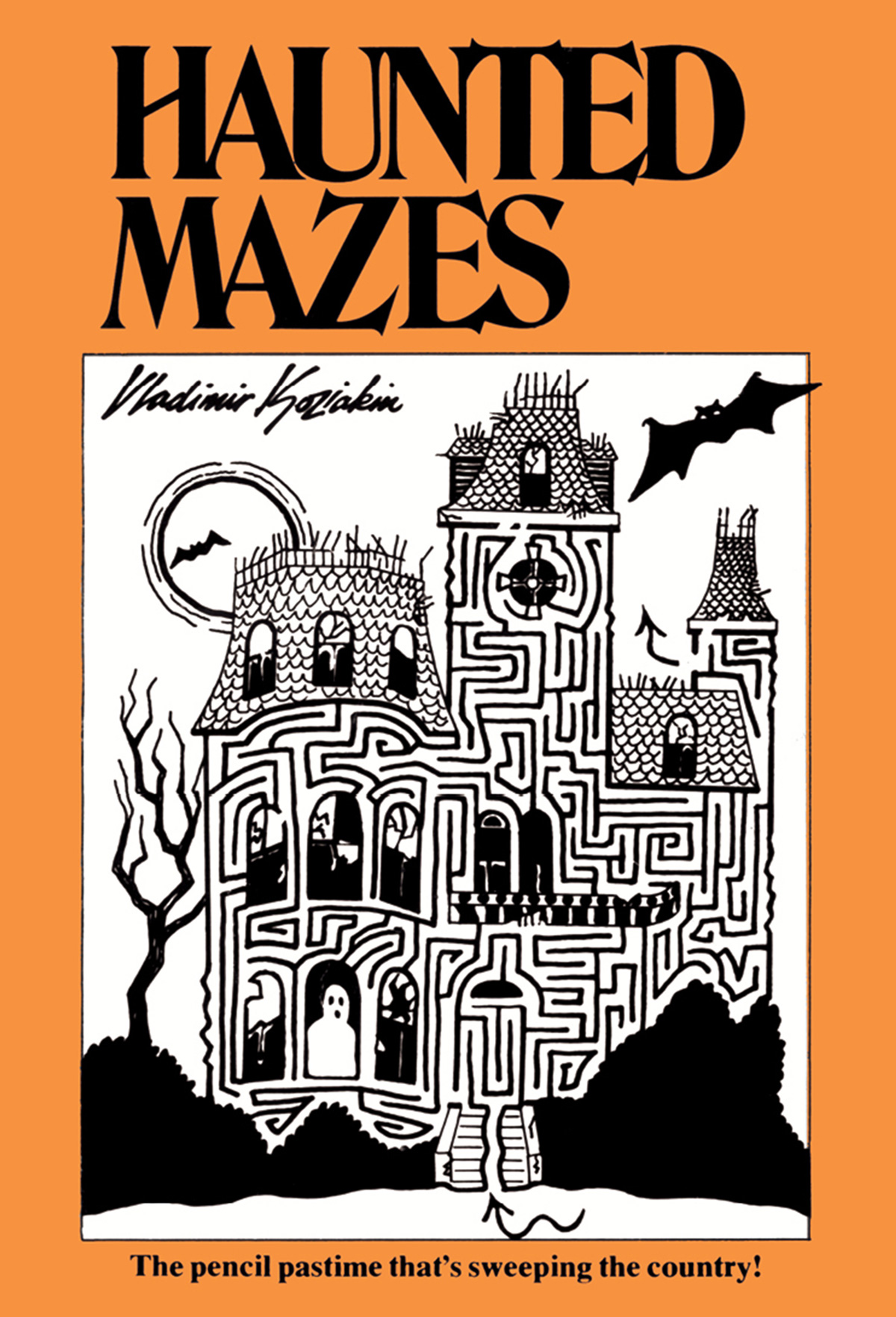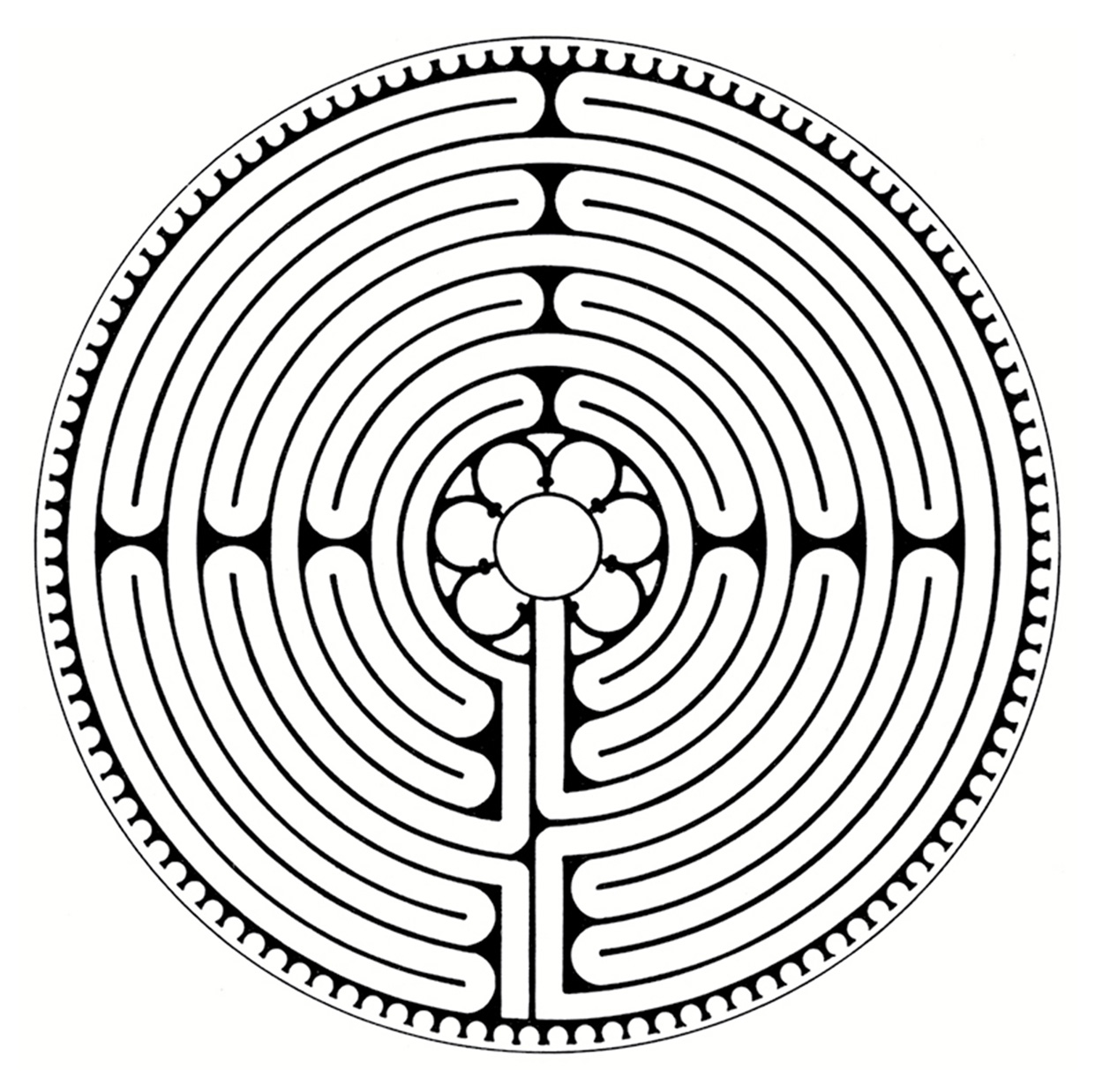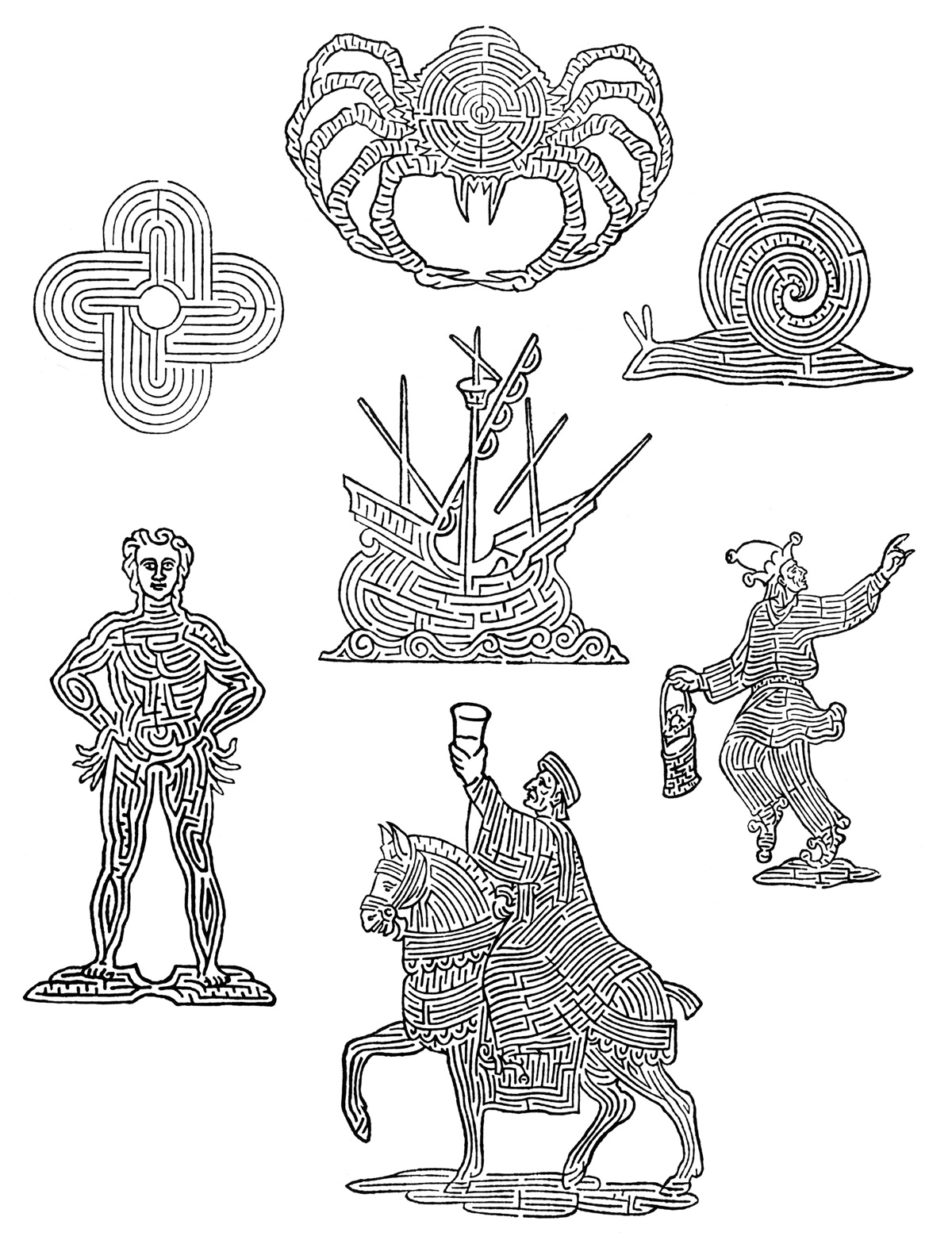Haunted Mazes
Inside the labyrinth
Joe Milutis

I’m getting to the age where I’m finding things in junk stores for which I didn’t even know I had nostalgia. One of these objects, Vladimir Koziakin’s Haunted Mazes, a cheap Scholastic Press–type collection of mazes in the shapes of luna moths, Frankenstein heads, weird trees, and voodoo masks, expertly blended the prepubescent longing for the macabre with the opportunity for geeky sublimation, which in the 1970s was generously afforded by a profusion of maze games. Koziakin’s small volume, charming like a junior grimoire, held no small magic for me at the time. Mazes were such a part of my childhood in the 1970s that the rediscovery of Haunted Mazes led me to reflect on the ontogenic significance of these meanders through “Mr. Horror” (a maze within the humpback of a Quasimodo), “The Evil One” (a Satanic goat’s head), and the ironically titled “Best Seller” (a maze within a book titled Secrets of the Occult). But is it only me who finds a little bit of himself in these grotesque convolutions? This was magic mass-produced, after all, and it thus ought to have some evolutionary and historical significance for us all, a phylogenic as opposed to an ontogenic haunting, if you will.
There was a minor publishing explosion of mazes and maze games in the 1970s, from these chintzy versions with orange or red sprayed on the edges, to the more glossy, coffee-table offerings—the kind you could find at Spencer’s Gifts, full of Escheresque Op Art defiles and no “rated time limits.” You were supposed to trace the latter more like you would an art object than an obstacle course (if you could bring yourself to pencil them at all). There were the electronic spin-offs, which, along with the paper-and-pencil mazes, drew us out of the sensorium of dirt and bruises and into the hermetic, monastic interior. Atari offered up blind underground catacombs in its now legendary Adventure game, as well as the 8-bit hedge romps of its lesser-known cartridge Maze Craze. These games were always played in our house either to Wendy Carlos’s Switched-On Bach, or old Thelonious Monk stuck unceremoniously into the mouth of 2-XL (an educational toy that we soon discovered to be nothing more than an 8-track player in robot drag). As we traced these paths, we started to evolve technologically. Just as the nineteenth century had its proto-cinematic devices, so the 1970s had its proto-computer multimedia machines in the form of toys that would take us out of the backyard and into our own mediated world of domestic reverie and phantasmagoria. As zoopraxiscopes, magic lanterns, and phenakistiscopes trained the eye for the explosion of cinematic perception, so too lava lamps, black light posters, disco balls, fiber-optic pom-poms, Mad Libs, and, most importantly, mazes, trained an inward vision suitable for the digital implosion to come. These were our philosophical toys.

The maze is about going nowhere. It’s also about getting to the ultimate goal. That’s the philosophy of the maze, its infinity in a nutshell. It is a paradox as germane to the manic stasis of childhood as it is to the manic stasis of social networking and BitTorrent downloadaphilia. But the paradox is a pragmatic one. The Christian labyrinth, like the one on the floor of Chartres cathedral, provided a space for pilgrimage when Christian violence abroad made travel inadvisable: “These French labyrinths appear to have been called ‘la lieue’ or ‘Chemin de Jerusalem;’ they were placed at the west end of the nave, and people made a pilgrimage on their knees, following the windings of the pathway to the centre, which is said to have been called Sancta Ecclesia or Ciel.”[1] While these windings represented the path to salvation through the world of sin, they were also an invitation to play, as in Easter resurrection dances; that their choreography was determined by the labyrinth’s pattern gives credence to the idea that these floor mazes were a surviving pagan mnemonic of a more ancient celebratory dance. This Christian maze of the medieval era was neither the origin, nor the apotheosis, of the maze’s early development; it marks the historical point, however, when its circuits become hardwired in the human mind as moral and allegorical—a pars pro toto for the world at large.
There is too much mystery embedded in the earlier maze of the Greeks to decipher exactly what it meant, but it was definitely not a place of prayer and reflection. What we do know of the Greek myth allows us to admire the design of Daedalus’s invention, the “circuit-bending” of Theseus’s heroics, and the labyrinthine structure of the stories themselves that circulate through and are generated by the labyrinth. It may have guided a dance when all was said and done, but it most likely started off as an execution chamber—not a place you’d want to wind up, ruminating on the mortal coil. Until Theseus slayed the Minotaur at its center, youths from Athens were sent to die there on a regular basis.
The original violence at the heart of this myth is displaced and managed over time in a variety of ways, as if the maze enfolds a trauma within itself. It’s fairly common to say that the medieval Christian maze replaces the Greeks’ Minotaur with Satan, and Theseus with Christ; consequently, a more personal struggle with one’s God replaces the historical and geopolitical struggle (between Athens and Crete) that powered the labyrinth’s original form. But the labyrinth of the medievals still circuits its meaning into the world. When Norman Klein calls the medieval maze “an abbreviated kingdom tiny enough to slip into your pocket,”[2] I think he is alluding to the fact that the Christian maze, as a personal simulacrum of the kingdom of God, is at the same time the vehicle for the kind of stay-at-home imperialism to which we have grown inured. One can even go so far as to say that the Crusades-era maze displaces the Minotaur—or Satan—onto the Islamic world; campaigns to control Jerusalem are the externality buttressing the geopolitical architecture of Christian interiority afforded by the maze. The devotee is thus free to glory in a more abstract conquest, along the difficult but not dire path towards a marriage of heaven and earth; torture, bureaucracy, and the sacrifice of youths are elsewhere.
While one might be tempted to compare the historical loci of the labyrinth with the geopolitics of today, the analogy might be too hasty, too easy. Yet a recent Op-Ed in the Boston Globe has taken the opportunity to make wild connections between mazes and Iraq, and goes as far as to say that we merely need to change the maze into a labyrinth to get out.[3] Taking the lead from Hermann Kern’s impressive but finicky study of the labyrinth, some commentators have tried to distinguish the term labyrinth from the maze by asserting that the labyrinth is unicursal (one path that winds into and out of the center) while the maze is multicursal (many paths with culs-de-sac).[4] As evidenced by this Boston Globe piece, the influence of this newly invented distinction is deep. New Age writers have attributed so many magical powers to this idea of a meditational walking labyrinth without dead ends—based primarily on their interpretation of the Chartres model—that, in order to protect the integrity of this magic, they have waged a campaign of terminological reeducation, whereby labyrinth initiates must not use the term labyrinth to convey anything other than the single-path, meditational design. To more subtle writers, this distinction does not stick. Penelope Reed Doob, for example, who starts her study of the labyrinth with a flat-out statement that mazes and labyrinths are the same thing, writes that our focus on the essential multicursality of mazes and essential unicursality of labyrinths is too narrow—a theoretical instance of “concentrating on accidentia, in the Scholastic sense: on attributes that are not absolutely necessary for a thing to be a thing.”[5]

It seems to me that hidden behind contemporary etymological distinctions is an attempt to tame multicursality, by way of denigrating multicursal mazes as merely “childish” versions of more sober, unicursal ones.[6] Multicursality challenges meditative clarity with multiple versions, no clear centers, and a sense of ambivalence and confusion. These complications, however, are the point of the labyrinth. Even if we grant that labyrinth merely designates the one-path New Age labyrinth recycled from the medieval era, the object is still haunted by a misrecognition. For even the medievals retained a sense of the unicursal labyrinth’s ambages—the equivocation at the heart of its windings, which the New Age version does not readily admit.[7] Additionally, the labyrinth that is the legacy of the medieval period is enmeshed in a circuit of analogies to such a degree that it is impossible to map out all its symbolic equivalences and their implications without ending up in the muck of indistinction. This tendency of the labyrinth to connote so much is part of what makes it an antithesis to sureness, rationality, and clarity. Its structure is mystically congruent with the idea of a dark or enchanted forest; it is also a stand-in for earthly conundrum, brain fold, uterine canal, spiritual struggle, or psychosexual journey.[8] Its center: Mary, the alchemical rose, Jerusalem, princess, Minotaur, inner-self, lotus blossom. And of course there are the various rewards that the multicursal maze holds out for its young adepts (pots of gold, pies and cakes, utopian wonderlands of bunnies and lollipops). Labyrinthine confusion is not merely an issue of its tortuous corridors, its solution not merely the cheese in the corner. Labyrinth enfolds into labyrinth across times, cultures, and myths.
Another sticking point seems to be this: if labyrinths are only unicursal, why is it that one always says “the Cretan labyrinth” rather than “the Cretan maze”? After all, Daedalus constructed such an intricate brain-baffler that when Theseus threw his lot in with the other youths of Athens in order to slay the Minotaur, he could not do it without the help of Ariadne’s yarn; even though visual representations from the period show Daedalus’s creation to be unicursal, we usually imagine Theseus navigating a multicursal array of circuits. In what I think is intended as a bit of humor, André Gide tries to rectify this discrepancy in his novella Theseus by describing the labyrinth of Crete as a simple unicursal structure—yes, like the design we see on ancient Greek coins—but it’s not the architecture that traps you; it’s the perfume. As Gide has Daedalus explain:
I had noticed that certain plants, when thrown into the fire, give off as they burn semi-narcotic fumes. … I used them to fuel stoves which are kept alight day and night. The heavy vapours that emanate from them do not act merely on the will, which they send to sleep; they create an intoxication full of charm and rich in seductive errors, luring the brain into a vain activity as it allows itself to be voluptuously filled with mirages; … The operation of these vapours is not the same for everyone who breathes them in, and each person, in accordance with the hotchpotch his brain concocts for him, loses himself, if I may put it like this, in his own private labyrinth.[9]

While the actual space of Daedalus’s labyrinth is straightforward, the use of the term labyrinth here still implies the loss that only a multi-pathed space can really offer. If we say that labyrinths are only unicursal, and as such are better for us (like bran flakes or tofu), we have too much confidence that our own meditations will bring us easy peace and have ultimately underestimated how confounding even the simplest meander can be.[10] Gide was right to introduce the “hotchpotch of the brain,” since in some ways even the straight line becomes a-mazed with the introduction of human consciousness.
Mazes or labyrinths, then, are not merely puzzles—a word that, etymologically, means something placed before you (Mid. Eng. opposaile).[11] Rather, you place yourself within them, in ways a Rubik’s Cube would not accommodate; additionally, and most importantly, the maze is you. Your thoughts are “the house difficult of exit,” or laboriosos exitus domus (one fanciful origin for the word labyrinth).[12] The mere act of placing yourself somewhere becomes challenged by an ever-proliferating lattice that connects and confounds. In Faulkner’s Absalom, Absalom!, Rosa Coldfield (surely named for the alchemical rose at a labyrinth’s heart) runs up a flight of stairs for seventy-odd pages, and ran up them in her mind for years more.[13] Like Koziakin’s titular maze, the house is a deceptively unified entity, infiltrated by the truth of amazement:
I would enter—The face stopping me dead (not my body: it still advanced, ran on: but I, myself, that deep existence which we lead, to which the movement of limbs is but a clumsy and belated accompaniment like so many unnecessary instruments played crudely and amateurishly out of time to the tune itself) in that barren hall with its naked stair (that carpet gone too) rising into the dim upper hallway where an echo spoke which was not mine but rather that of the lost irrevocable might-have-been which haunts all houses, all enclosed walls erected by human hands, not for shelter, not for warmth, but to hide from the world’s curious looking and seeing the dark turnings which the ancient young delusions of pride and hope and ambition (ay, and love too) take.[14]

Many other modernist writers have materialized such mental labyrinths, pointing out the inadequacy of unicursal data entry, which characterizes the technology of the book. There have been, of course, hypertext writers who have more recently sought to further accommodate this mental overload by simulating the multiplicity of labyrinthine consciousness through the technology of links.
My ultimate point, however, is nothing so banal as, “Mazes help us understand the Internet.” If anything, they might help us gird ourselves for the betrayals of the digital, like the betrayals of youthful magic, for which sometimes we ourselves are responsible. The vast chaos of the Internet becomes simplified—for example, through the agency of a basic web portal tailored to our needs—and like the progression from Greek to New Age mazes, childhood to adulthood, our brain matter follows. This simplification is not necessarily a bad thing and, in fact can help us organize and evolve, but simplicity can easily slip into dogma. I sympathize with the desire to lift the image of a shining, simple archetype out of the mess of the labyrinth’s history, in the same way that I understand people for whom the Bible is the book as struggling to overcome a particular brand of information anxiety. Overloads of data and memory failures make finding oneself in the labyrinth (of the computer or elsewhere) a difficult task. If self itself is the labyrinth, however, then one must take into account its infinite intricacies and booby traps too; it is in fact part of the monstrosity, what Bataille in his essay on the labyrinth calls “the virulent madness of … autonomy in the total night of the world.”[15] For him, existence is either more complex than or insufficient to the concept of being, which the labyrinth embodies, tames, and turns into a destiny. “A man is only a particle inserted in unstable and entangled wholes,” he says, using the word particle to imply a quantum complexity. “This extreme instability of connections alone permits one to introduce, as a puerile but convenient illusion, a representation of isolated existence turning in on itself.”[16] It is the labyrinth, conceived as unicursal, which is puerile—instigating a vain sense of Oedipal comfort “sought by the abandoned man wherever knots and concentrations are formed throughout a vast incoherence”[17]—not the realistic, multicursal maze. This maze is the labyrinth’s uncanny.[18]
Have I merely reversed a false polarity? Again, just attempting to untangle the paradoxes engendered here makes any notion of a “true labyrinth” seem suddenly seductive and inevitable. So, while the unicursal labyrinth may be regressive, I must admit that as what may be called a “spiritual technology” it can provide a temporary center in a zone of eccentric drifting. A shared labyrinth is rarely a comfort, however: think of the unicursal IKEA on a Saturday, or the tradition of leaving in the center of the meditational labyrinth something that you would like to get rid of. A recent visit to one of these walking labyrinths led me to the trash heap of other people’s crap: packs of cigarettes, a white plastic crucifix, a pink paperclip, a Halls cough drop wrapper, rotten oranges, a matchbox from a spa in Vermont. Even though Kern, in what is to me more evidence of his over-particularity, emphasizes that the spiral is not a labyrinth, I think that Robert Smithson’s Spiral Jetty (1970) is an example of a unicursal, meditational labyrinth that avoids the well-intentioned but ultimately wrong-headed purities of the yoga-spa labyrinth. In the film documentation of Spiral Jetty, in addition to seeing that Smithson was reading W. H. Matthews’s 1922 book Mazes and Labyrinths (it’s in a pile with other books on dinosaurs, sedimentation, and lost worlds), we understand that this classic earthwork was meant to be traversed rather than beheld, if only by Smithson and only temporarily. As an eccentric “site,” Spiral Jetty can only provide an absurd or stopgap centering.
In the end, if we must hold to thinking phylogenically, or even teleologically, the Christian form of the labyrinth—linking sin to its disorienting paths, redeemed by the circular form that encloses it, “a maze both in bono and in malo, … evil encompassed by divinely perfect form”[19]—was historically superseded, even though it now is held to be today’s “true labyrinth.” As this Christian meditational maze gave way to love labyrinths in the Renaissance, a new genre of maze appeared that in some ways would critique this encapsulation of evil meanders within abstract divine destiny. The woodcuts of Francesco Segala—an architect of the sixteenth century and perhaps the first creator of the paper maze—are almost indistinguishable from Koziakin’s Haunted Mazes from the 1970s. If Bataille calls for laughter to traverse the networks of our labyrinthine interconnections, these images perhaps had parodic intent. Instead of a divine circle with a cruciform center, the maze is held within emphatically secular forms: a dog, a jester, a crab, a pilgrim, a ship, a snail, a whale, a man.
Labyrinths and mazes call for two forms of identification: you as a dot traversing the intricacy of dilemma, and you as the whole that can be apprehended at once. You identify with both the path and the structuring form of the path, in the same way that you conceive of a word in a paragraph. But the twist of Segala’s mazes is this: instead of identifying with the sinful dizzied pilgrim on one hand, and the static divine order that guarantees the destiny of your dizziness on the other, these two vantage points are collapsed into one. You make your way within the form of a creature that also makes its way. These are mazes within the amazed, and as such, your destiny is momentarily linked to a form that is also uncertain as to its destiny. You may be reminded, perhaps, of Koziakin’s 1982 The Amazing Amazeman in Super-Maze Adventure. I’m not sure whether the Amazing Amazeman is to be pitied or if he is a genius of love and laughter. But, imagining him, one is brought back to the question that has always bugged archeologists: is the labyrinth a plan for a prison or instructions for a dance?

- W. R. Lethaby, Architecture, Mysticism, and Myth (New York: Braziller, 1975), p. 150.
- Norman M. Klein, The Vatican to Vegas: A History of Special Effects (New York: The New Press, 2004), p. 101.
- James Carroll, “The Labyrinth of Iraq,” The Boston Globe, 10 October 2005. Available at boston.com/news/globe/editorial_opinion/oped/articles/2005/10/10/the_labyrinth_of_iraq. Accessed 30 July 2012.
- Hermann Kern, Through the Labyrinth: Designs and Meanings Over 5,000 Years (New York: Prestel, 2000).
- Penelope Reed Doob, The Idea of the Labyrinth from Classical Antiquity through the Middle Ages (Ithaca, NY: Cornell University Press, 1990), p. 45.
- Of the many maze books following Kern’s, a few recent authors rectify the legacy of his distinction by either complexifying the etymological issues involved, or outright using the terms interchangeably—Craig Wright, David Willis McCullough, Jacques Attali, and Norman Klein. The work of Penelope Reed Doob from 1990 provides a compelling and rigorous counter-argument to Kern’s and the more classic text by W. H. Matthews claims no distinction, reminding readers that “as to the actual origin and primary purpose of these devices we cannot be dogmatic on the evidence before us, and herein, perhaps, lies a good deal of their charm.” (p. 5) The authors who belabor the notion of a “true” labyrinth include Lauren Artress, Helen Curry, Helmut Jaskolski, and Melissa Gayle West, the last of whom explicitly describes the maze as childish in comparison to the labyrinth.
- For more on medieval ambages, see Doob, Idea of the Labyrinth, pp. 53–54.
- It is important to note that the unicursal, medieval labyrinth encourages this carnival of analogies, because, while deceptively simple, it turns its windings into a mirror of the world.
- André Gide, Theseus and Oedipus, trans. Andrew Brown (London: Hesperus, 2002), pp. 24–25.
- In Idea of the Labyrinth, Doob writes that while the multicursal structure incorporates some semblance of free will, the unicursal maze is one in which “individual responsibility diminishes” (p. 50), where we rely on “the passive dependence on the whim of the maze-maker,” and which is “technically simple but potentially more horrifying than the multicursal path.” See pp. 50–51. She reminds us that both unicursal and multicursal mazes have as their essence “confusion and frustration.”
- Ernest Weekley, The Romance of Words (New York: Dutton, 1913), p. 59.
- Doob, Idea of the Labyrinth, p. 96.
- Amazement—if we want to give the word the more dire sense that Faulkner gave it—becomes a mental trap precisely when the nomadic genius for escaping danger and creating new paths, what Jacques Attali calls “the wisdom-legacy of nomads to their sedentary descendants,” becomes confounded by the memorializing impulse of the sedentary. Jacques Attali, The Labyrinth in Culture and Society: Pathways to Wisdom, trans. Joseph Rowe (Berkeley: North Atlantic, 1999), p. 17.
- William Faulkner, Absalom, Absalom! (New York: Vintage, 1972), p. 137.
- Georges Bataille, “The Labyrinth,” in Visions of Excess: Selected Writings, 1927–1939, ed. Allan Stoekl (Minneapolis: University of Minnesota Press, 1985), p. 174.
- Ibid.
- Ibid., p. 175.
- T. J. Demos’s essay “Duchamp’s Labyrinth” explores the idea of an ethic of homelessness as it relates to the diaspora of European surrealists during World War II. In relation to Duchamp’s evocation of the labyrinth as a difficult object in his later, American work, Demos quotes Theodor Adorno: “It is part of morality not to be at home in one’s home.” There is, then, a politics to the uncanny (as we can see played out, for example, in the recent film Pan’s Labyrinth). See T. J. Demos, “Duchamp’s Labyrinth: First Papers of Surrealism, 1942,” October, no. 97 (Summer 2001), p. 108.
- Craig Wright, The Maze and the Warrior: Symbols in Architecture, Theology, and Music (Cambridge, MA: Harvard University Press, 2001), p. 24.
Joe Milutis is a writer, media artist, and assistant professor of art at the University of South Carolina. He is the author of Ether: The Nothing That Connects Everything (University of Minnesota Press, 2006). For more information, see www.joemilutis.com
Spotted an error? Email us at corrections at cabinetmagazine dot org.
If you’ve enjoyed the free articles that we offer on our site, please consider subscribing to our nonprofit magazine. You get twelve online issues and unlimited access to all our archives.